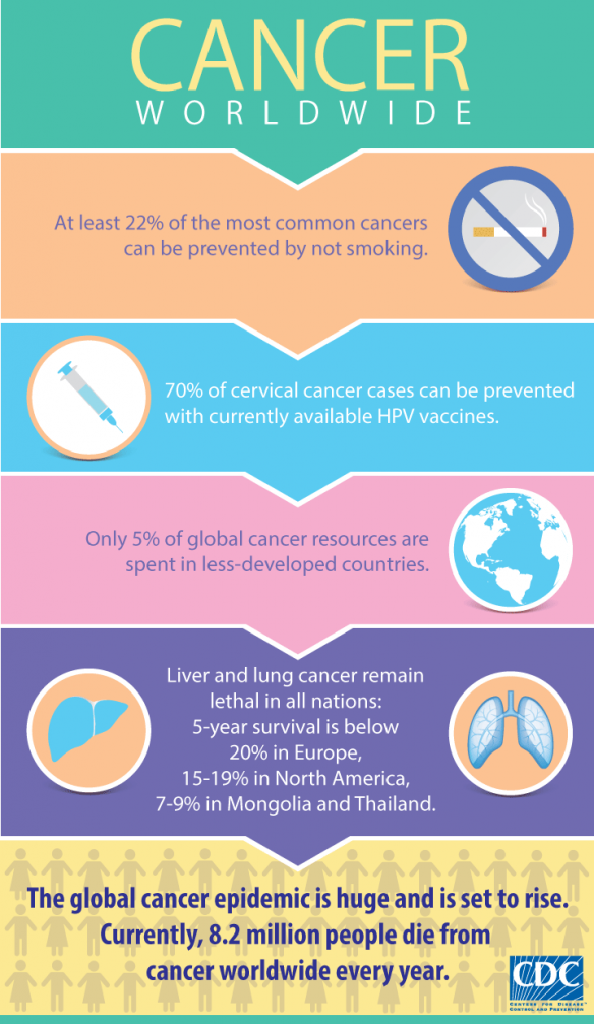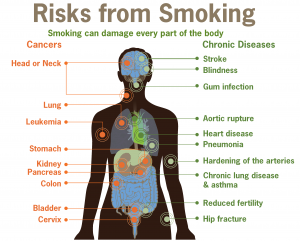Lung Cancer: Risks, Prevention, and Early Detection
November is Lung Cancer Awareness Month
In Canada and the United States, lung cancer is the leading cause of all cancer deaths for men and women, with an approximately 70-75% mortality rate for patients diagnosed with it.
 (Infographic: CDC Global)
(Infographic: CDC Global)
Over 95% of all new lung cancer cases are older adults age 50+. It’s not only smokers that get lung cancer, although current and former smokers represent approximately 85% of patients diagnosed with lung cancer in North America, according to Lung Cancer Canada.
In Canada, 75% of lung cancers are not caught until Stage 3 or 4, which contributes to the high mortality rate from lung cancer. Stigma over smoking combined with the high mortality rate/fewer lung cancer survivors, has impacted the support and resources available to fund cancer research.
There are 2 types of lung cancers, and the most common is non-small cell lung cancer (80% of lung cancer cases); less common is the small cell lung cancer. Lung cancer treatment options and prognosis vary based on the type of cancer and what stage it is at.
Lung Cancer Risk Factors
 Smoking – Approximately 85% of lung cancer diagnoses are or have been, smokers. 50% of patients diagnosed with lung cancer are active smokers; another 35% are currently non-smoking, but had been smokers and quit. (Infographic: SERO)
Smoking – Approximately 85% of lung cancer diagnoses are or have been, smokers. 50% of patients diagnosed with lung cancer are active smokers; another 35% are currently non-smoking, but had been smokers and quit. (Infographic: SERO)- Aging – The risk of developing lung cancer increases markedly for mature and older adults age 50+. Of the 26,665 new cases of lung cancer diagnosed in Canada in 2015, it was estimated that incidences rates of new lung cancer patients (men and women) were:
- 44% (11,600) – mature adults and “young” seniors between the ages of 50 and 69.
- 32% (8,400) – septuagenarian senior citizens between the ages of 70 and 79.
- 22% (5900) – the elderly and older, octogenarian senior citizens age 80+.
- Radon Gas Exposure – Naturally occurring and virtually undetectable, radon gas exists in every indoor environment and is extremely radioactive. It’s been estimated by WHO (World Health Organization) and Health Canada that between 14-16% of all lung cancers are due to to radon exposure.
Lung Cancer Symptoms
According to the American Cancer Society, the many signs and symptoms of lung cancer may include:
- Coughing – a cough that doesn’t go away, or gets worse; couging up blood, or blood-colored spit or phlegm)
- Chest pain – chest pain, that may get worse with deep brething, coughing, or laughing.
- Hoarseness
- Weight loss, loss of appetite
- Shortness of breath, wheezing
- Feeling tired or weak
- Chronic infections – ie, bronchitis or pneumonia that keeps coming back or never clears up
More advanced lung cancer symptoms may include (but are not limited to) these symptoms:
- Bone pain – ie, pain in the back or hips.
- Headache, limb weakness, dizziness/balance problems.
- Jaundice (yellowing of skin and eyes).
- Lumps near the skin’s surface.
Depending on which part of the lung has been affected by the cancer, there are many additional symptoms. Consult your doctor and medical professional team for more information.
Lung Cancer Prevention and Early Detection
Regular medical check-ups and early diagnosis are critical steps in reducing the mortality rate from lung cancer. If you suspect you may have lung cancer or are at high risk for developing lung cancer, in addition to consulting your doctor, there are steps you can take to help improve your outcome:
- Quit Smoking. For long-time smokers, the chance of dying from a smoking-related cause is approximately 50%. In addition to lung cancer, smoking is responsible for 30% of all cancer deaths and is a high risk factor for cancers of the mouth, throat, stomach, bladder, kidneys, and pancreas. Studies have shown that only 5 years after quitting smoking, the risk of developing lung cancer is 30-60% lower; 20 years after quitting smoking, the risk of developing lung cancer in ex-smokers is the same as for non-smokers.
- Radon Gas Emissions Testing – Test your home and work environments for radon gas levels. Kits are available to test radon levels over periods of time ranging from 1 month to 1 year (recommended minimum time for testing is 3 months)
- Lung Cancer Screening – Low-dose CT scans (LDCT) for people at high risk for developing lung cancer may detect lung cancer in earlier stages, offering more successful treatment strategies and outcomes.
Additional Lung Cancer Information & Resources
- Lung Cancer Canada – http://www.lungcancercanada.ca
- American Cancer Society – http://www.cancer.org
- Health Canada – Radon – http://www.hc-sc.gc.ca/ewh-semt/radiation/radon/index-eng.php
- Take Action on Radon – http://www.takeactiononradon.ca
- How to Test Your Home for Radon – http://www.cancer.org/cancer/news/features/radon-gas-and-lung-cancer
*Images are public domain or Creative Commons licensed & sourced via Wikimedia Commons or Flickr, unless otherwise noted*
